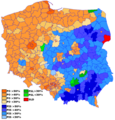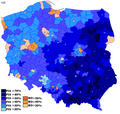Poland A and B
Poland A and B(Polish:Polska A i B) refers to thehistorical,political,andculturaldistinction between the western and the eastern part of the country, with Poland "A", west of theVistula,being much more developed and having faster growth than Poland "B", east of the river. The General Secretary of thePolish Chamber of CommerceMarek Kłoczko said in his 2007 interview that the divisions are more spread out and forming three separate categories: Poland "A" are the metropolitan cities; Poland "B" is the rest of the country; and Poland "C" are the plains and the landscape parks east of the Vistula (Poland "Z", according to Kłoczko), which require a different treatment.[1]
Reportedly, Poland's well-off cities areWarsaw,Gdańsk,Wrocław,andPoznań,and the ones struggling with less investment are in the east:Rzeszów,Lublin,OlsztynandBiałystok.[1]However, current unemployment statistics for Poland in general fail to show that distinction and even indicate an opposite trend in recent years, with the northwest reporting rates of unemployment higher than east-central Poland. In 2014, among the highest in the nation were theKuyavian-PomeranianandWest Pomeranian Voivodeships(compare the historic railroad map and the administrative map, right, with the 2014 unemployment map, from business portal eGospodarka.pl);[2]while among the lowest in the country was the east-centralMasovian Voivodeship.[3]

Distinction
[edit]The distinction is unofficial and in some ways oversimplified, but it is widely acknowledged and discussed in Poland.[5]

Historically, the source of Poland "A" and "B" can be traced to the period of thepartitions of Poland,and different policies of the partitioners, which resulted in a much larger industrial development of thePrussian partition,compared to theAustrianandRussianpartitions (including the so-called easternKresy) where the imperial exploitation policies were rampant.[1]
In this divide, it has to be noted that Poland's borders were changing over the centuries. They moved westward after 1945, to reflect thePoland of the Piastsrather thanthe Poland of Jagiellonians.For instance, Warsaw was initially a settlement in eastern Poland. When it became a capital city in the 16th century, and historically in the developed as a central part of theKingdom of Poland(the Crown), later western-central part ofthe Commonwealth.Now is situated in the central-eastern part of it. The slower growing western provinces are often former German regions that were already densely populated and well-developed in terms of infrastructure and industry before 1945, now populated mostly by Poles from the former Eastern Polish regions. For example, the above-mentioned Olsztyn was part ofPrussiasince the times of theTeutonic Order.
Politics
[edit]The difference between Poland's "A" and "B" is particularly evident in the voting patterns of the two regions. During the 1990s, Poland "A" tended to favour theDemocratic Left Alliance(Sojusz Lewicy Demokratycznej, or SLD), as a secular, socially liberalde factosuccessor in post-1989 politics to the formerruling partyof thePRL.Poland "B" on the other hand voted eitherPSLor theSolidarity,both representingChristian-democraticvalues.[6]The2001 electionwas the only one when Poland A and B were not seen on the maps, as SLD won both in the east and the west of the country. Since circa 2005, Poland saw a realignment in its political system. Residents of Poland "A" have supported theliberal conservativepartyCivic Platform(PO). Residents of Poland "B" (excluding Warsaw), on the other hand, tend to support thenational conservativeLaw and Justiceparty (PiS).
Gallery
[edit]-
Administrative map of Poland with results of the2007 electionsto theSenate of Poland;orange:Civic Platform,navy blue:Law and Justice
-
2011 Polish parliamentary election,PiS (blue), KO (orange)
-
2018 Polish local elections to regional assemblies (voivodeships) PiS (blue), KO (orange)
-
Law and Justice's main support (dark blue) is concentrated in the south-east of the country (formerRussian PartitionandAustrian Partition), results of the2015 Polish parliamentary election
-
Law and Justice's main support (dark blue). PiS has seen increased support in the2019 Polish parliamentary election
-
2020 Polish presidential election 1st round, PiS (blue), KO (orange)
-
2020 Polish presidential election second round, PiS (blue), KO (orange)
-
2023 Polish parliamentary election- Senate results, PiS (blue), Opposition (orange)
-
2024 Polish local elections to regional assemblies (constitutencies) PiS (blue), KO (orange)
In popular culture
[edit]On 26 January 2016, the albumKarabinbyMaria Peszekwas released. It includes the song "Polska A, B, C i D". A day later, the song was released as a single and it peaked at number one on thePolish Radio Three Chart.[7][8]
Poland "B" is mentioned in the 2020 Polish horror filmNobody Sleeps in the Woods Tonight.
See also
[edit]- List of Polish voivodeships by GRP
- Partitions of Poland
- Recovered Territories
- The globalNorth-South divide,and similar socioeconomic divides in:
References
[edit]- ^abcIwona Borkowska,Polska Polsce nierówna,RaportPolska.pl2008-06-04. Internet Archive. Retrieved December 16, 2014.
- ^"Stopa bezrobocia 2014".Map of unemployment by region 2014.eGospodarka.pl. Archived fromthe originalon 8 April 2015.Retrieved8 April2015.
- ^"Unemployment in Poland in February 2014".Raporty i prognozy.eGospodarka.pl.
At the end of February 2014 the highest unemployment rate in Poland was found invoivodeships:Warmian-Masurian(22.3%),Kuyavian-Pomeranian(18.8%),West Pomeranian(18.5%),Świętokrzyskie(17.1%),Podkarpackie(16.9%) andLubusz(16.3%). The lowest unemployment rates in the country were found in:Wielkopolskie(10.0%),Masovian(11.4%),Silesian(11.7%) andLesser Poland(12.1%).
- ^Wiesław Samecki,Ekonomia 3: Centralny Okręg Przemysłowy 1936–1939,Wydawnictwo Uniwersytetu Wrocławskiego, 1998,ISBN83-229-1634-5.Introduction.
- ^Pueyo, Tomas (29 February 2024)."Why Are There 2 Polands?".Medium.Retrieved4 March2024.
- ^Kowalczyk, Krzysztof (15 March 2014)."Typologia polskich partii politycznych według kryterium programowego"[The typology of political parties in Poland made on the basis of their political platform](PDF).Środkowoeuropejskie Studia Polityczne(in Polish) (1): 73–99.doi:10.14746/ssp.2014.1.6.hdl:10593/22710.Retrieved19 August2021.
- ^""Polska A B C i D" czyli Maria Peszek wraca i zniechęca do nienawiści "(in Polish). 27 January 2016.
- ^"Archiwum LP3, notowanie 1781, z dn. 18.03.2016 | Lista Przebojów Programu Trzeciego".
Further reading
[edit]- Kozak M., Pyszkowski A., Szewczyk R. (red.) 2001, Słownik Rozwoju Regionalnego, PARR, Warszawa.
- Iwona Borkowska,Polska Polsce nierówna,RaportPolska.pl2008-06-04. Internet Archive.
- Gazeta Wyborcza (1999) 'Polska A, B i C' (Poland A, B and C), August 4









